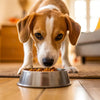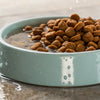What Can I Give My Dog Instead of Kibble? A Comprehensive Guide to Dog Food Alternatives
- Houndsy
Table of Contents
- Introduction
- Understanding the Nutritional Needs of Dogs
- Safe Dog Food Alternatives
- Foods to Avoid
- Preparing Alternative Meals
- Transitioning Back to Kibble
- Conclusion
Introduction
Did you know that nearly 30% of dog owners have found themselves in a situation where they ran out of their dog’s kibble? Whether due to a missed grocery trip, an unexpected delivery delay, or simply an oversight, this common dilemma can leave pet parents scrambling for alternatives to ensure their furry friends stay fed and happy. As dedicated pet lovers, we understand how stressful it can be to face an empty food bowl, and that’s why we’re here to help!
In this blog post, we will explore safe, nutritious alternatives to kibble that you can find in your kitchen or at the grocery store. By the end of this guide, you will have a clear understanding of what you can give your dog instead of kibble, along with tips on how to prepare these options safely and effectively. We’ll also discuss the importance of maintaining a balanced diet for your canine companion, ensuring they receive the nutrients they need to thrive.
So, let’s dive into the world of dog food alternatives, and together, we’ll find solutions that can keep your pup satisfied and healthy!
Understanding the Nutritional Needs of Dogs
Before we dive into specific alternatives, it's essential to understand our dogs' nutritional needs. Dogs are omnivores, meaning they require a balanced diet that includes proteins, carbohydrates, fats, vitamins, and minerals. A high-quality kibble is formulated to meet these dietary needs, but when we need to substitute, we must ensure that any alternatives also provide a balanced intake.
The Importance of a Balanced Diet
A balanced diet supports your dog's overall health, energy levels, and mood. Key nutrients include:
- Proteins: Essential for muscle development and repair.
- Fats: Provide energy and support cell function.
- Carbohydrates: Supply energy and aid digestion.
- Vitamins and Minerals: Vital for various bodily functions, including immune health and bone strength.
When considering what to feed your dog instead of kibble, it’s crucial to ensure that any alternative meal maintains this balance.
Safe Dog Food Alternatives
When you find yourself out of kibble, the good news is that many common human foods are safe and nutritious for dogs. Here are some categories of food you can consider:
1. Cooked Lean Meats
Lean meats are an excellent source of protein for dogs. Here are some options:
- Chicken: Cooked and unseasoned, chicken is a go-to protein source for many dogs.
- Turkey: Similar to chicken, turkey is a lean meat that many dogs enjoy.
- Beef: Cooked, unseasoned beef can also be a nutritious choice, but keep it lean to avoid excess fat.
2. Vegetables
Many vegetables are safe for dogs and can provide essential vitamins and minerals. Some great options include:
- Carrots: A crunchy snack that is low in calories and high in fiber.
- Green Beans: Low in calories and a good source of vitamins.
- Sweet Potatoes: Rich in vitamins A and C, they can be a nutritious addition to your dog’s diet.
- Pumpkin: Great for digestion, pumpkin is high in fiber and nutrients.
3. Fruits
Fruits can be a healthy treat and source of vitamins for dogs. Here are a few safe options:
- Apples: High in fiber and vitamin A, just make sure to remove the seeds and core.
- Blueberries: Packed with antioxidants, they make a great snack.
- Bananas: A sweet treat that is easy to digest and full of potassium.
- Watermelon: Hydrating and refreshing, just be sure to remove the seeds and rind.
4. Eggs
Cooked eggs are a great source of protein and can be easily added to your dog’s meals. They should be cooked thoroughly to avoid the risk of salmonella.
5. Dairy Products
While not all dogs can tolerate dairy, some can enjoy it in moderation. Good options include:
- Plain Yogurt: A source of probiotics that can aid digestion.
- Cottage Cheese: High in protein and calcium, but should be given in moderation.
6. Grains
While dogs don’t require grains, they can be a good source of carbohydrates if your dog enjoys them. Some options include:
- Brown Rice: A bland option that can help with digestive issues.
- Oats: Cooked plain oats can be a nutritious addition.
- Quinoa: A protein-rich grain that is safe for dogs.
Foods to Avoid
While many human foods are safe for dogs, some can be toxic. It's crucial to avoid the following:
- Chocolate
- Onions and Garlic
- Grapes and Raisins
- Avocado
- Macadamia Nuts
- Xylitol (a common sweetener found in sugar-free products)
Always check with your veterinarian if you’re unsure about a specific food.
Preparing Alternative Meals
Now that we’ve covered what you can give your dog instead of kibble, let’s discuss how to prepare these meals safely.
Balancing the Meal
When preparing a meal for your dog, aim for a balanced ratio. A general guideline is to combine two parts protein (like lean meat or eggs) with one part grains (like rice or oats) and one part vegetables. For example, you could mix two cups of cooked chicken, one cup of cooked rice, and one cup of steamed carrots.
Cooking Tips
- Cook Thoroughly: Always cook meats thoroughly to eliminate harmful bacteria.
- Avoid Seasoning: Do not add salt, spices, or sauces, as these can be harmful to dogs.
- Portion Control: Be mindful of portion sizes to prevent overfeeding and to keep your dog’s weight in check.
Storage and Freshness
If you prepare a larger batch, store leftovers in the refrigerator for up to three days. Always let the food cool before serving it to your dog.
Transitioning Back to Kibble
If your dog has been eating homemade meals for a few days, it’s important to transition back to their regular kibble slowly. Start by mixing in small amounts of kibble with their homemade food, gradually increasing the kibble ratio over several days. This will help prevent digestive upset.
Conclusion
While running out of kibble can feel daunting, knowing what you can give your dog instead can ease your worries. With a variety of safe and nutritious options available in your kitchen, you can create balanced meals that will keep your dog happy and healthy until you can restock their kibble supply. Remember to always consult your veterinarian if you have concerns about your dog’s diet or health.
As we strive to simplify and elevate the dog-feeding experience, we invite you to explore our innovative solutions, like the Houndsy Kibble Dispenser. With its mid-century modern design and perfect portion control, it’s the ultimate tool to ensure your dog’s feeding routine is convenient and stylish.
FAQ
Q: Can I feed my dog human food every day?
A: While some human foods are safe for dogs, they should not replace a balanced dog food diet long-term. It's best to use them as temporary substitutes or treats.
Q: How much of an alternative meal should I feed my dog?
A: Start by matching the volume of their regular meal. If your dog usually eats two cups of kibble, give them two cups of the alternative meal until you can resume their regular diet.
Q: Are there any human foods I should avoid entirely?
A: Yes, foods like chocolate, grapes, onions, and xylitol are toxic to dogs and should be avoided.
Q: What if my dog has food allergies?
A: If your dog has specific allergies, consult your veterinarian before introducing new foods to ensure they are safe.
Q: How can I ensure my dog is getting a balanced diet?
A: Consult with your veterinarian for guidance on your dog's specific dietary needs and how to balance homemade meals effectively.
By understanding the dietary needs of our dogs and utilizing safe food alternatives, we can ensure our furry friends remain happy and healthy, even when the kibble runs out!












